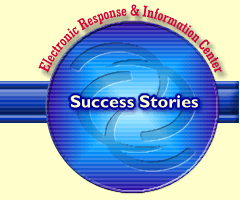
Showing Off Bar Coding Benefits2-D Bar Code Badge Solution Used at Trade Shows Worldwideto Collect Show Registrant Information and Sales Leads for ExhibitorsThis year, they will be at more than 50 trade shows, ranging from the 200-exhibitor TeleCom XVII to Comdex Beijing, five times the size of its granddaddy in Las Vegas.
2-D Symbol Holds Registrant DataWhen AET makes the badges, they encode and print the registrant data in a PDF-417 2-D symbol. Show management scans the symbols to verify attendance at exhibition halls and seminars and measure traffic levels by day or hour.The encoded badges end some of the show-day confusion for exhibitors too. Rather than collecting business cards with hand-written notes, which may get lost, the sales leads are captured electronically, eliminating errors or missed sales.
Hand-Held Collects Badge DataAt the heart of the system—now used on average by half of show exhibitors—is the Compsee Apex II hand-held terminal which collects, stores and later downloads the data. The cellular-phone-size unit has a scanner port for the Welch Allyn 3400PDF scanning device and a printer port. AET programs the terminals in Basic for each show. “It was very important to us that we were able to write a program and download it to all these units at a moment’s notice in a familiar language,” says Michael Nolan, owner of AET.
Information Shared By AllDuring the show, attendees’ badges are scanned not only by the show’s management, but at the booths. The custom AET software pulls the segments of information from the symbol and parses it to produce the lead’s name and other information, plus the information about the required action.This latter information can be put into the hand-held through the alpha-numeric keypad or through scanning linear bar codes assigned to specific follow-up activities.
Passing On The Sales LeadsAfter the trade show, exhibitors take the hand-held to the AET service desk where the captured information is offloaded onto diskettes. The file can then be into any contact management database package, so the exhibitor can print letters to send with the requested literature, and automatically forward leads to the correct sales people. Exhibitors who want immediate hard copy of lead information at the booth, or an end-of-the-day summary (such as number of leads and their interests), can print it at any time.
Choosing A Hand-Held Product“There were a hundred products I could have chosen,” Nolan says. But he says Compsee was the most responsive to developmental challenges.Compsee worked as the systems integrator to marry the scanner to the Apex II terminal to make the system work as one unit. And the company changed the original unit from a one-dimensional reader using the same wand-emulation port.
Going The Extra MileThe big challenge was in supplying adequate power. Nolan says, “We decided, after purchasing the units, that we had to power the unit externally. Compsee went out of its way to find a solution.”Nolan is pleased with the terminal manufacturer for other reasons, too, he reports. A last-minute call that might have been deferred by other manufacturers resulted in shipment of 50 cables via FedEx within ten minutes. He say’s “It’s the difference between feeling like you’re working with a company that knows you, knows your application, and what you do for a living, and someone who just answers the phone.”
Fulfilling Multiple NeedsThe terminals have worked well for show management companies, who use the documented show and booth attendance to help sell more space. And it’s worked well for exhibitors, who can better realize their investment in trade shows because they no longer have to deal with countless pieces of paper and a long, hassle-filled, error-prone lead capture process at shows.Reprinted from:
Chilton Company March/April 1997 American Exposition
Technologies |
top
Home |
The Company |
Systems Solutions |
Products & Pricing |
Educational Resources
Software & Support |
Reseller Resources |
Contact Compsee |
Compsee Live Chats!